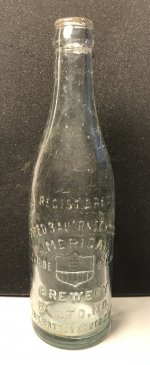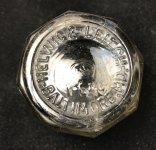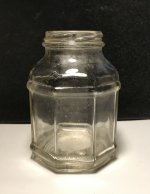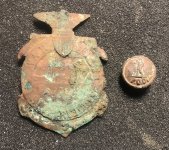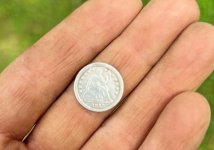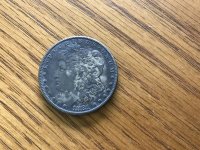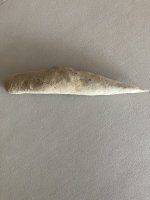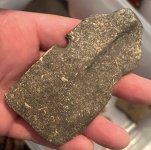You are using an out of date browser. It may not display this or other websites correctly.
You should upgrade or use an alternative browser.
You should upgrade or use an alternative browser.
Found my first complete Baltimore beer bottle and more
- Thread starter 8Reales
- Start date
- Jun 8, 2006
- 6,127
- 8,491
- Detector(s) used
- Whites, Minelab, Tesoro, and custom machines
- Primary Interest:
- Metal Detecting
Good finds! I really like the beer bottle and the medal!!
Diggin Dude
Silver Member
Very cool!!
islamoradamark
Silver Member
- Aug 26, 2016
- 3,630
- 3,993
- Primary Interest:
- All Treasure Hunting
very nice
Red-Coat
Gold Member
Nice bottles. It’s true that Helwig & Leitch produced (or rather packed) all kinds of chemical/pharmaceutical products including things like medicinal turpentine, peroxide and laundry bluing but that wasn’t their main business. They principally made or packed food products and some of their smaller bottles get misidentified as pharmaceutical since they sold things like spices, food flavouring extracts, and essences.
Their specialities included pickles, relishes, condiments, ketchups, mayonnaise, sandwich spreads, jams, jellies and peanut butter. I would be pretty sure you have a mustard jar. The company was founded in 1888 and taken over by Jewett & Sherman in 1947, although products bearing the H&L name continued for a while thereafter. With a screw-cap closure, the jar is going to be from the first half of the 1900s but I can’t read the jar maker mark for a potentially better dating from your picture.
The beer bottle, as you’ve probably discovered is from sometime between 1899-1919 since those are the opening and closing dates for Bauernschmidt’s “American Brewery”.
Their specialities included pickles, relishes, condiments, ketchups, mayonnaise, sandwich spreads, jams, jellies and peanut butter. I would be pretty sure you have a mustard jar. The company was founded in 1888 and taken over by Jewett & Sherman in 1947, although products bearing the H&L name continued for a while thereafter. With a screw-cap closure, the jar is going to be from the first half of the 1900s but I can’t read the jar maker mark for a potentially better dating from your picture.
The beer bottle, as you’ve probably discovered is from sometime between 1899-1919 since those are the opening and closing dates for Bauernschmidt’s “American Brewery”.
8Reales
Bronze Member
- Thread starter
- #11
Simply a ton of info
Thank you so much
That octagonal bottle
Definitely looks more like
Food related than medicine
Again thank for all the wonderful info
Thank you so much
That octagonal bottle
Definitely looks more like
Food related than medicine
Again thank for all the wonderful info
Nice bottles. It’s true that Helwig & Leitch produced (or rather packed) all kinds of chemical/pharmaceutical products including things like medicinal turpentine, peroxide and laundry bluing but that wasn’t their main business. They principally made or packed food products and some of their smaller bottles get misidentified as pharmaceutical since they sold things like spices, food flavouring extracts, and essences.
Their specialities included pickles, relishes, condiments, ketchups, mayonnaise, sandwich spreads, jams, jellies and peanut butter. I would be pretty sure you have a mustard jar. The company was founded in 1888 and taken over by Jewett & Sherman in 1947, although products bearing the H&L name continued for a while thereafter. With a screw-cap closure, the jar is going to be from the first half of the 1900s but I can’t read the jar maker mark for a potentially better dating from your picture.
The beer bottle, as you’ve probably discovered is from sometime between 1899-1919 since those are the opening and closing dates for Bauernschmidt’s “American Brewery”.
erfranks
Hero Member
- Mar 3, 2021
- 811
- 1,099
- Detector(s) used
-
Nautilus DMC-2B
Minelab Equinox 800
White TRX pinpointer
- Primary Interest:
- All Treasure Hunting
Great Saves!!!
Red-Coat
Gold Member
Simply a ton of info
Thank you so much
That octagonal bottle
Definitely looks more like
Food related than medicine
Again thank for all the wonderful info
You’re welcome. Sometimes it’s not clear how much folks have already found out about the history of their items. At the risk of telling you things you already know, this is Fred Bauernschmidt’s potted history:
Frederick Bauernschmidt was born in Baltimore, Maryland in 1863. His father George was a brewer who had emigrated from Wambach, Germany, in 1853 and worked in the Baltimore brewing industry before opening his own brewery in 1864. George’s business was bought out by the Maryland Brewing Company conglomerate in 1898 as part of their aggressive strategy to wipe out small competitors. Frederick learned the trade from his father and had borrowed money to begin construction of his own modern brewery in 1897, which opened as the “American Brewery” in 1899. By the time it closed in 1919 due to prohibition, he was producing around 350,000 barrels of beer a year. Frederick remained active in the community thereafter and made significant contributions to support the Union Memorial Hospital, plus other organizations and associations devoted to providing care for Baltimore’s citizens before his death in 1933.
- Aug 3, 2017
- 4,725
- 6,501
- 🏆 Honorable Mentions:
- 1
- Detector(s) used
- AT MAX/AT PRO/GPX-4500, Equinox 800, Garrett Pro Pointer,NEL Attack Coil, Lesche diggers, and the custom made in the USA Freeloader Pack Mule Pouch!
- Primary Interest:
- All Treasure Hunting
You have been crushing it lately!!! Congrats

8Reales
Bronze Member
- Thread starter
- #16
Again very helpful info
You’re welcome. Sometimes it’s not clear how much folks have already found out about the history of their items. At the risk of telling you things you already know, this is Fred Bauernschmidt’s potted history:
Frederick Bauernschmidt was born in Baltimore, Maryland in 1863. His father George was a brewer who had emigrated from Wambach, Germany, in 1853 and worked in the Baltimore brewing industry before opening his own brewery in 1864. George’s business was bought out by the Maryland Brewing Company conglomerate in 1898 as part of their aggressive strategy to wipe out small competitors. Frederick learned the trade from his father and had borrowed money to begin construction of his own modern brewery in 1897, which opened as the “American Brewery” in 1899. By the time it closed in 1919 due to prohibition, he was producing around 350,000 barrels of beer a year. Frederick remained active in the community thereafter and made significant contributions to support the Union Memorial Hospital, plus other organizations and associations devoted to providing care for Baltimore’s citizens before his death in 1933.
Users who are viewing this thread
Total: 2 (members: 0, guests: 2)
